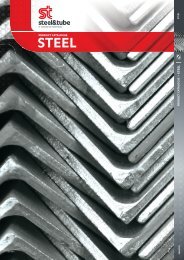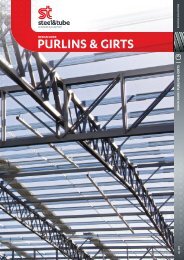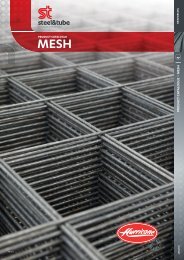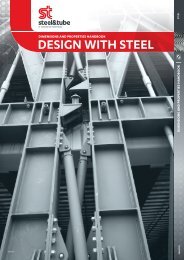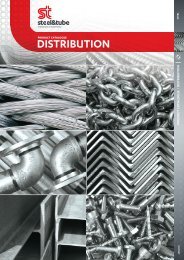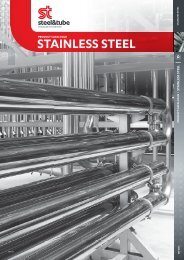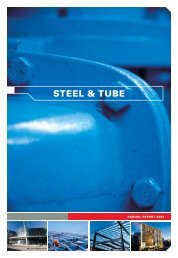PRODUCT
ROOFING SOLUTIONS - Steel & Tube
ROOFING SOLUTIONS - Steel & Tube
- No tags were found...
Create successful ePaper yourself
Turn your PDF publications into a flip-book with our unique Google optimized e-Paper software.
Design for Durability<br />
Steel & Tube Roofing and Cladding Solutions on CD-ROM or in printed form,<br />
provides design and installation details for residential and commercial applications.<br />
Contact your local branch or the Technical Helpline for your copy.<br />
With correct product selection, installation and maintenance, your Steel & Tube<br />
Roofing Products roof will remain attractive and weatherproof for many years.<br />
Unfavourable design practices will detrimentally affect the performance of your roof<br />
and should be avoided. If any of the following situations are evident in your design<br />
you should contact your Steel & Tube Roofing Products representative for advice.<br />
• Areas of roofing, cladding and rainwater systems unwashed by rainfall will<br />
accumulate atmospheric debris which can become corrosive when damp.<br />
These areas will require maintenance depending on the product used and the<br />
environment. Refer to the Maintenance section of this publication.<br />
• Do not discharge water runoff from inert materials such as Zincalume ® steel,<br />
pre-painted roofing, tiles or clear sheeting onto unpainted galvanised roofing and<br />
gutters, as the corrosive salts formed in this situation are unstable and can lead to<br />
premature corrosion.<br />
• Where two different metals are in contact one metal will tend to sacrifice itself to<br />
protect the other. A similar effect can occur with water flowing over dissimilar metals.<br />
In particular, avoid runoff from copper or brass onto Zincalume ® steel roofing, and<br />
avoid contact with, or runoff from unpainted lead onto Zincalume ® steel.<br />
• Fasteners should be compatible with the roofing material chosen and have<br />
durability not less than the material being fastened. Stainless steel or aluminium<br />
fasteners should be used with pre-painted aluminium roofs.<br />
• Wall cladding should terminate at least 50mm above ground level, and be kept<br />
free of vegetation.<br />
Storage<br />
Products are despatched from the factory in top condition, however the material can<br />
be ruined before installation by poor storage practices. Premature deterioration due to<br />
poor storage may be avoided if these simple guidelines are followed:<br />
• On arrival, ensure sheets are dry. If wet, open the pack and separate the sheets to<br />
allow them to dry. Store packs of the product off the ground in a sheltered position<br />
providing some fall to allow water to run off. Protect packs with a loose fitting<br />
waterproof cover, allowing air to circulate.<br />
• Contact with wet cement should be avoided at all times.<br />
Installation<br />
The installation of metal roofing products is a specialised field requiring knowledge and<br />
experience of numerous issues with regard to trade practice and material compatibility.<br />
• Poor handling prior to or during installation can cause damage which may affect the<br />
appearance and ultimate performance of the product. Don’t handle sheets roughly or<br />
carelessly or drag or slide sheets over each other or rough surfaces, as damage to the<br />
coating may occur. Equipment used to handle the sheets should be clean and free of<br />
dirt and grit.<br />
• Soft soled shoes should be worn whenever walking on the product to prevent<br />
damage to the coating; traffic up the roof should be in the pans of the profile and<br />
across the roof should be on the purlin line.<br />
• Prior to installation ensure that the tops of the purlins or girts are all in the same<br />
plane; if packing or easing is necessary ensure this is not to the detriment of the<br />
connection between the fastener and the structure.<br />
• Sheets should be lapped away from the line of sight wherever possible to enhance<br />
aesthetic appeal and all sheets should be stop ended at the top, and lipped at the<br />
bottom on pitches below 8º.<br />
• Ensure that the anti-capilliary edge is fitted as the external overlap and is visible from<br />
the top side.<br />
• The use of touch-up paints is not recommended; if a pre-painted sheet is excessively<br />
damaged by scratching it should be replaced. Accessories should be colour matched<br />
prior to installation.<br />
• Regularly clean up the area by sweeping swarf, offcuts, rivet shanks and loose<br />
fasteners with a soft-bristled broom. Collect and remove all debris daily as unsightly<br />
staining from swarf and other unprotected steel items can occur overnight.<br />
• The strippable film applied to some prepainted products must be removed within two<br />
weeks of installation, or earlier if storage is in direct sunlight.<br />
• Recommended references are the New Zealand Steel Installer's Guide and the Steel &<br />
Tube Roofing and Cladding Solutions.<br />
7



